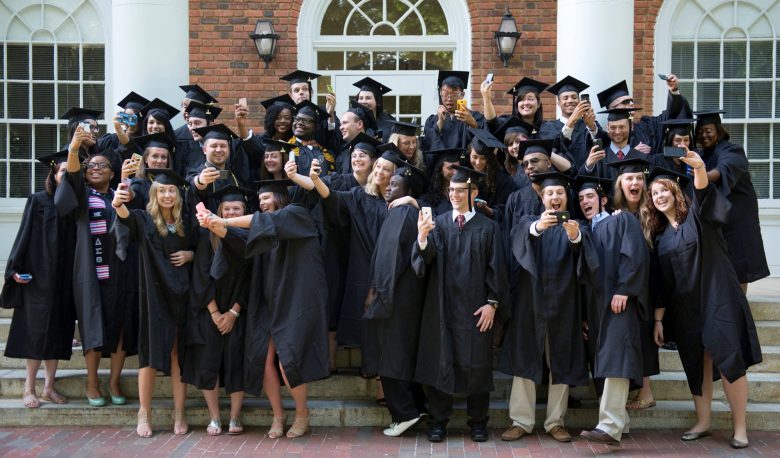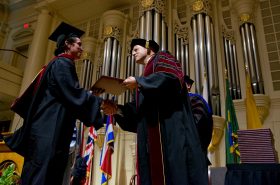MJ Jacobsen, senior vice president of communications for the National Geographic Society, challenged the 38 “digital natives” in the Interactive Media Class of 2014 to never be complacent about learning new things.

Before adopting its characteristic yellow border, there was a time when the cover of the National Geographic Magazine was simply brown—unattractive, plain, boring brown.
Revenues and circulation were not exciting either, perhaps because the stories that filled its pages were geared more toward professional geographers. It took a man of vision, then-president Alexander Graham Bell, to turn things around by redefining geography to include “the world and all that is in it” and urging staffers to show this world through images.
Since then the magazine has not stopped evolving, a characteristic MJ Jacobsen, senior vice president of communications for the National Geographic Society, says is fundamental if one wants to succeed in the ever-changing media landscape, and one graduates in the Master’s Program in Interactive Media at Elon University were encouraged to develop.
“If you, the iMedia graduates of 2014, are equipped to embrace new technologies on critical topics, media organizations will come knocking, but it’s also important that you remember nonprofits need your skills, too; they need help telling their stories,” Jacobsen said in her keynote address during the program’s commencement ceremony May 22 at Whitley Auditorium. “You’ve always had the intuitive skills as digital natives, and with the iMedia classwork, you now have a broad understanding of the entire interactive media landscape.”
But she was quick to warn the graduates that while the occasion was to celebrate their accomplishments thus far, their hard work was not over. “You must evolve your storytelling, possibly the platforms you’ve spent 10 months mastering,” she said.
View a photo gallery of the Commencement activites.
Perhaps for the Class of 2014 this might not be a daunting task, but it certainly was for Jacobsen five years ago, when the industry was going through “cataclysmic changes.”
“Digital natives like you were entering the workforce,” she said, “and instinctively understood interactive media. For people of my generation, it was a scary world. We were used to serving the audience a baked cake. We never asked what you wanted for dessert. We were serving cake.”
Now the audience tells the society’s staff what they want with every retweet, share and like on social media, forcing them to change how they do business, Jacobsen said. Photographers shoot video as well as stills and images that historically were guarded for their big reveal in the magazine—sometimes having been kept under wraps for up two years—are now being shared on Instagram. Writers, too, had to adapt, going from having months to write extensive narratives to also turn copy faster for the website since putting out a monthly magazine was no longer enough to maintain audiences’ interest.
While the society reaches 500 million people worldwide each month, largely via the printed magazine, Jacobsen said they also have a rapidly-growing social media audience, which includes six million Twitter followers, 26 million Facebook friends and thousands of people who participate in their Google chats. They also have dozens of scientists and explorers who blog from the field.
“By being sensitive to the news cycle and responding with our own distinctive take on events in the worlds of science, cultures and technology, National Geographic is positioned as a thought leader, providing trusted information as people need it most, and that’s when the news is happening—not once a month,” she added.
The fact they were graduating from Elon’s intensive, 10-month program meant the 38 candidates in the interactive media program have what it takes to make these kinds of transformations possible, as long as they are willing to keep evolving. “At National Geographic we need employees with the skills you have learned, but never be complacent about learning new things; it will only enhance your storytelling,” Jacobsen said.
She also encouraged students to remain connected to one another for much of their professional success, she said, will likely be thanks to those relationships. “Most jobs come from a buddy you know who is hiring or somebody who will help you get hired when the time is right.”
That message resonated with the graduates. Ashley Gilmer, who delivered the student address, said the shared experiences during the past 10 months have created a strong bond among members of the class. She encouraged her classmates to be proud in their accomplishment and to never settle. “Make it your mission to die with memories, not just dreams,” she said. “You worked hard and you deserve every good thing that is coming your way.”
Elon President Leo M. Lambert, too, challenged the class to be connected, particularly to their alma mater. “As you prepare for the next chapter of your lives, I hope you will think of yourselves as lifelong members of the Elon family and full partners in the success of this graduate program, the School of Communications and Elon University,” he said. “We need your great ideas and leadership here as we chart the next 125 years of Elon’s exciting history.”
 He charged them to be nimble and use their life to build something great and meaningful. “On this ceremonial and celebratory evening, I charge you, as new Elon graduates to carry forth this light into a world crying out for illumination,” Lambert said referring to Elon’s motto, Numen Lumen, which means spiritual and intellectual light. “The professional light this class carries is a 21st century light—illuminating technologies that launched the Arab spring, connected human beings during natural disasters, forged new communities, forms of commerce and social movements.
He charged them to be nimble and use their life to build something great and meaningful. “On this ceremonial and celebratory evening, I charge you, as new Elon graduates to carry forth this light into a world crying out for illumination,” Lambert said referring to Elon’s motto, Numen Lumen, which means spiritual and intellectual light. “The professional light this class carries is a 21st century light—illuminating technologies that launched the Arab spring, connected human beings during natural disasters, forged new communities, forms of commerce and social movements.
“Your life, your strength, your light can, should and will make a difference in helping many who are far less privileged than you.”


